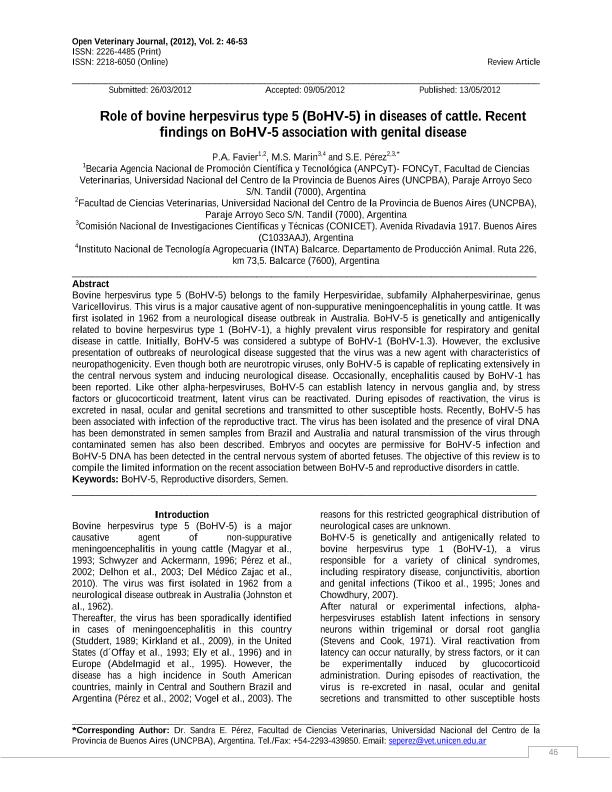Mostrar el registro sencillo del ítem
dc.contributor.author
Favier, Paula Ariela

dc.contributor.author
Marin, Maia Solange

dc.contributor.author
Perez, Sandra

dc.date.available
2019-12-16T21:19:39Z
dc.date.issued
2012-05
dc.identifier.citation
Favier, Paula Ariela; Marin, Maia Solange; Perez, Sandra; Role of bovine herpesvirus type 5 (BoHV-5) in diseases of cattle. Recent findings on BoHV-5 association with genital disease; National Authority for Scientific Research; Open Veterinary Journal; 2; 5-2012; 46-53
dc.identifier.issn
2218-6050
dc.identifier.uri
http://hdl.handle.net/11336/92331
dc.description.abstract
Bovine herpesvirus type 5 (BoHV-5) belongs to the family Herpesviridae, subfamily Alphaherpesvirinae, genus Varicellovirus. This virus is a major causative agent of non-suppurative meningoencephalitis in young cattle. It was first isolated in 1962 from a neurological disease outbreak in Australia. BoHV-5 is genetically and antigenically related to bovine herpesvirus type 1 (BoHV-1), a highly prevalent virus responsible for respiratory and genital disease in cattle. Initially, BoHV-5 was considered a subtype of BoHV-1 (BoHV-1.3). However, the exclusive presentation of outbreaks of neurological disease suggested that the virus was a new agent with characteristics of neuropathogenicity. Even though both are neurotropic viruses, only BoHV-5 is capable of replicating extensively in the central nervous system and inducing neurological disease. Occasionally, encephalitis caused by BoHV-1 has been reported. Like other alpha-herpesviruses, BoHV-5 can establish latency in nervous ganglia and, by stress factors or glucocorticoid treatment, latent virus can be reactivated. During episodes of reactivation, the virus is excreted in nasal, ocular and genital secretions and transmitted to other susceptible hosts. Recently, BoHV-5 has been associated with infection of the reproductive tract. The virus has been isolated and the presence of viral DNA has been demonstrated in semen samples from Brazil and Australia and natural transmission of the virus through contaminated semen has also been described. Embryos and oocytes are permissive for BoHV-5 infection and BoHV-5 DNA has been detected in the central nervous system of aborted fetuses. The objective of this review is to compile the limited information on the recent association between BoHV-5 and reproductive disorders in cattle.
dc.format
application/pdf
dc.language.iso
eng
dc.publisher
National Authority for Scientific Research
dc.rights
info:eu-repo/semantics/openAccess
dc.rights.uri
https://creativecommons.org/licenses/by-nc-sa/2.5/ar/
dc.subject
Bohv-5
dc.subject
Reproductive Disorders
dc.subject
Semen
dc.subject.classification
Ciencias Veterinarias

dc.subject.classification
Ciencias Veterinarias

dc.subject.classification
CIENCIAS AGRÍCOLAS

dc.title
Role of bovine herpesvirus type 5 (BoHV-5) in diseases of cattle. Recent findings on BoHV-5 association with genital disease
dc.type
info:eu-repo/semantics/article
dc.type
info:ar-repo/semantics/artículo
dc.type
info:eu-repo/semantics/publishedVersion
dc.date.updated
2019-01-23T19:04:27Z
dc.journal.volume
2
dc.journal.pagination
46-53
dc.journal.pais
Libia

dc.description.fil
Fil: Favier, Paula Ariela. Ministerio de Ciencia. Tecnología e Innovación Productiva. Agencia Nacional de Promoción Científica y Tecnológica; Argentina. Universidad Nacional del Centro de la Provincia de Buenos Aires. Facultad de Ciencias Veterinarias; Argentina
dc.description.fil
Fil: Marin, Maia Solange. Consejo Nacional de Investigaciones Científicas y Técnicas; Argentina. Instituto Nacional de Tecnología Agropecuaria. Centro Regional Buenos Aires Sur. Estación Experimental Agropecuaria Balcarce; Argentina
dc.description.fil
Fil: Perez, Sandra. Consejo Nacional de Investigaciones Científicas y Técnicas; Argentina. Universidad Nacional del Centro de la Provincia de Buenos Aires. Facultad de Ciencias Veterinarias; Argentina
dc.journal.title
Open Veterinary Journal
dc.relation.alternativeid
info:eu-repo/semantics/altIdentifier/url/https://www.openveterinaryjournal.com/2012/OVJ-027-03-12%20P.A.%20Favier%20et%20al.pdf
Archivos asociados
